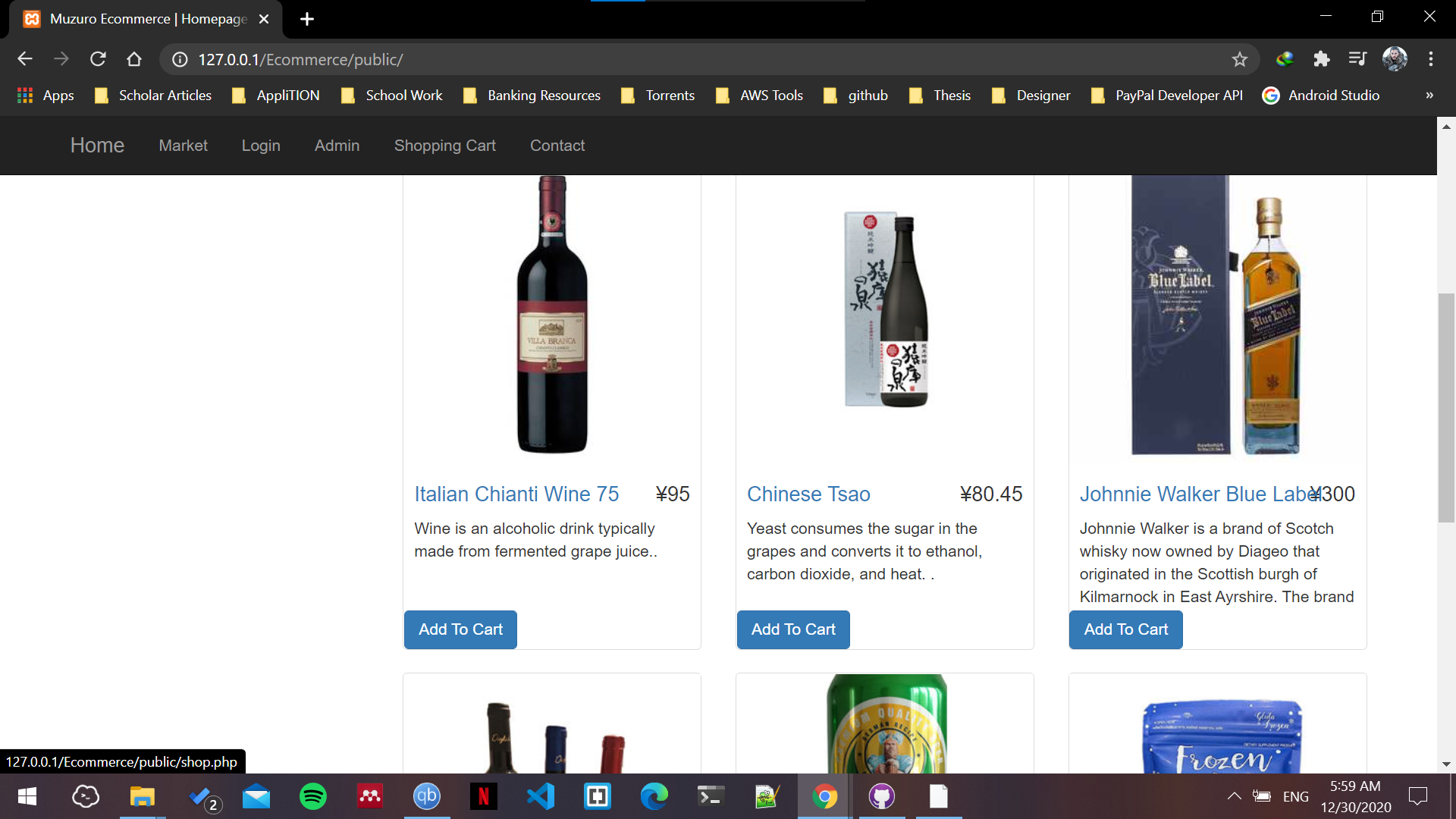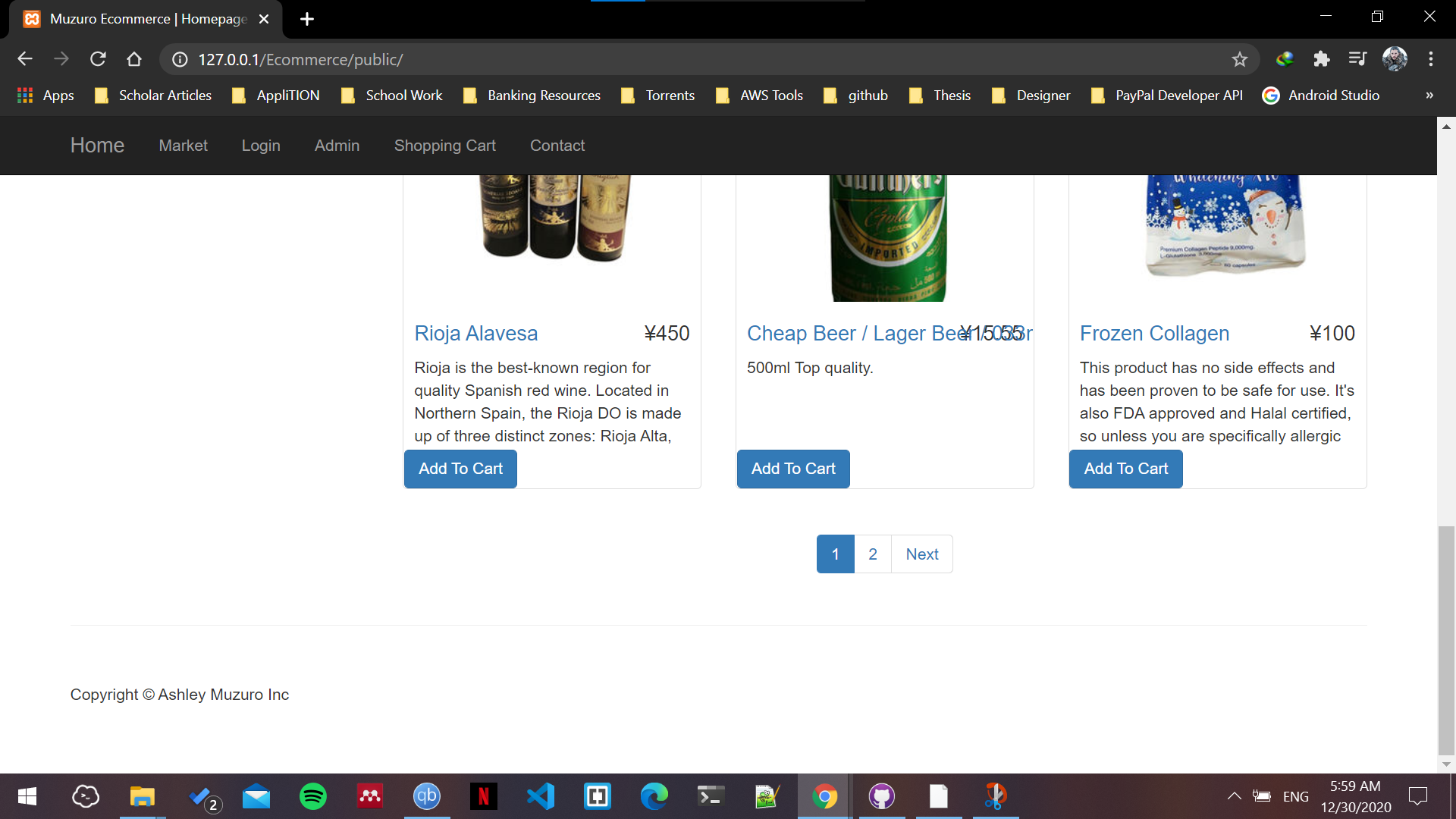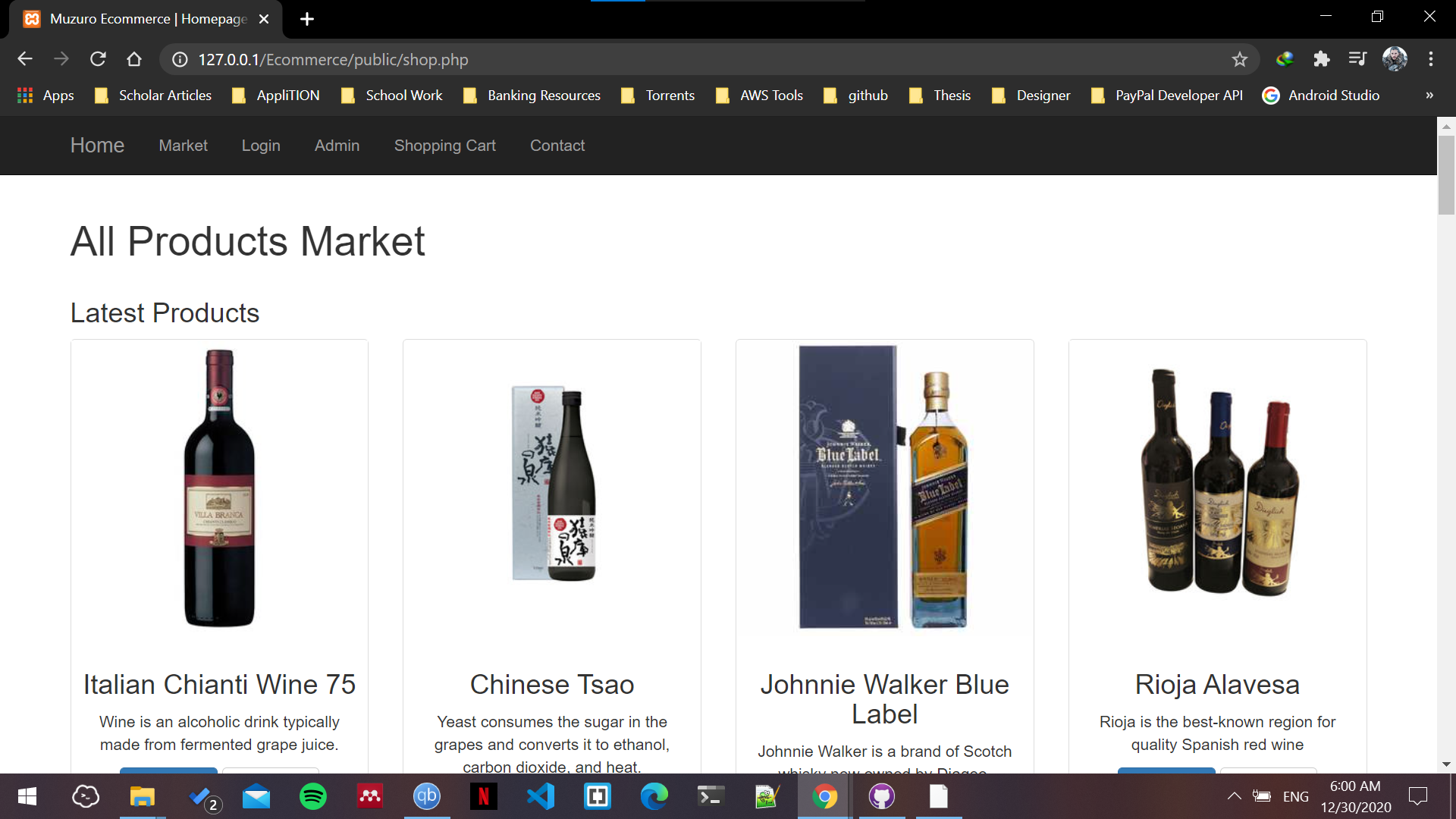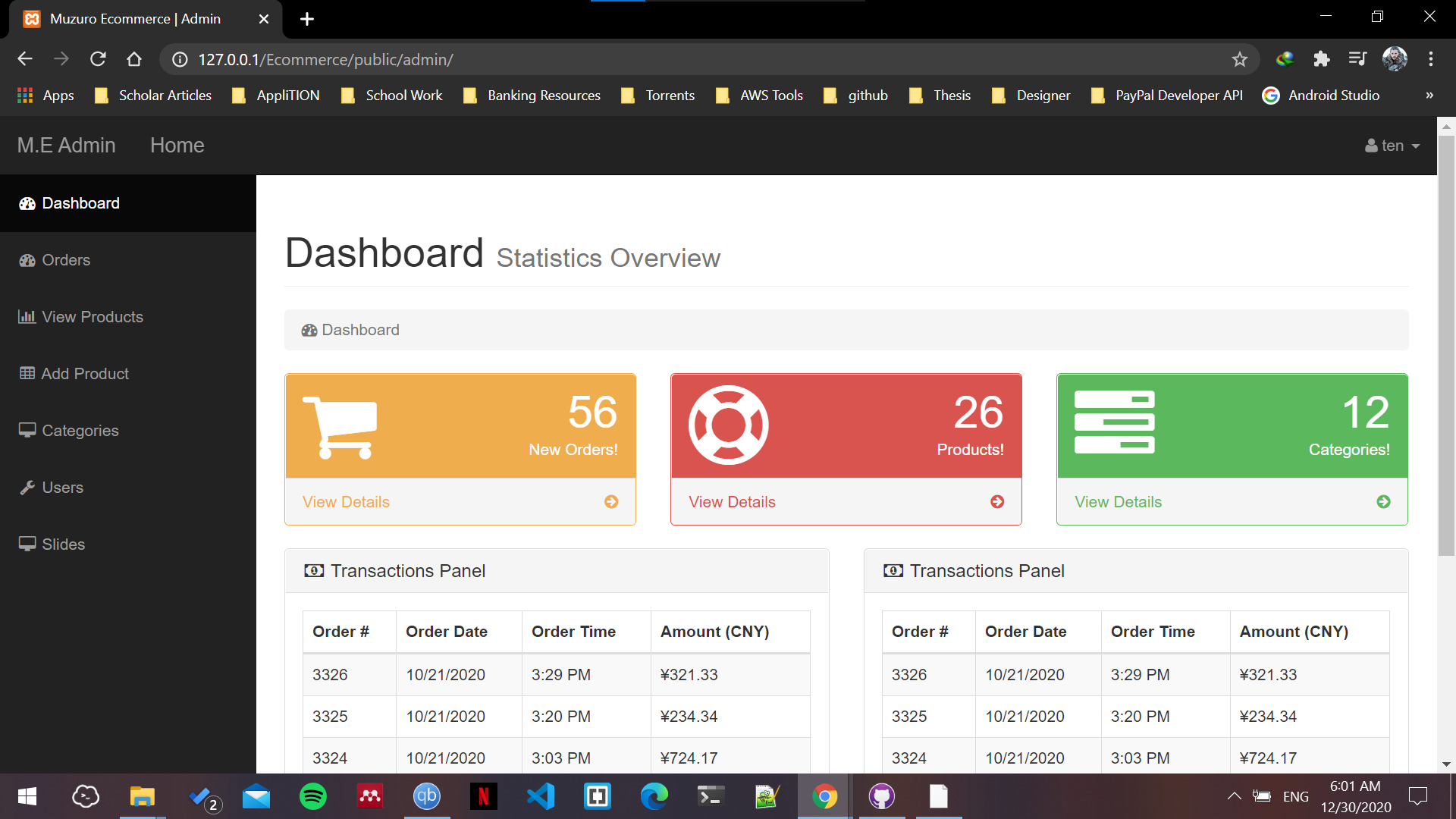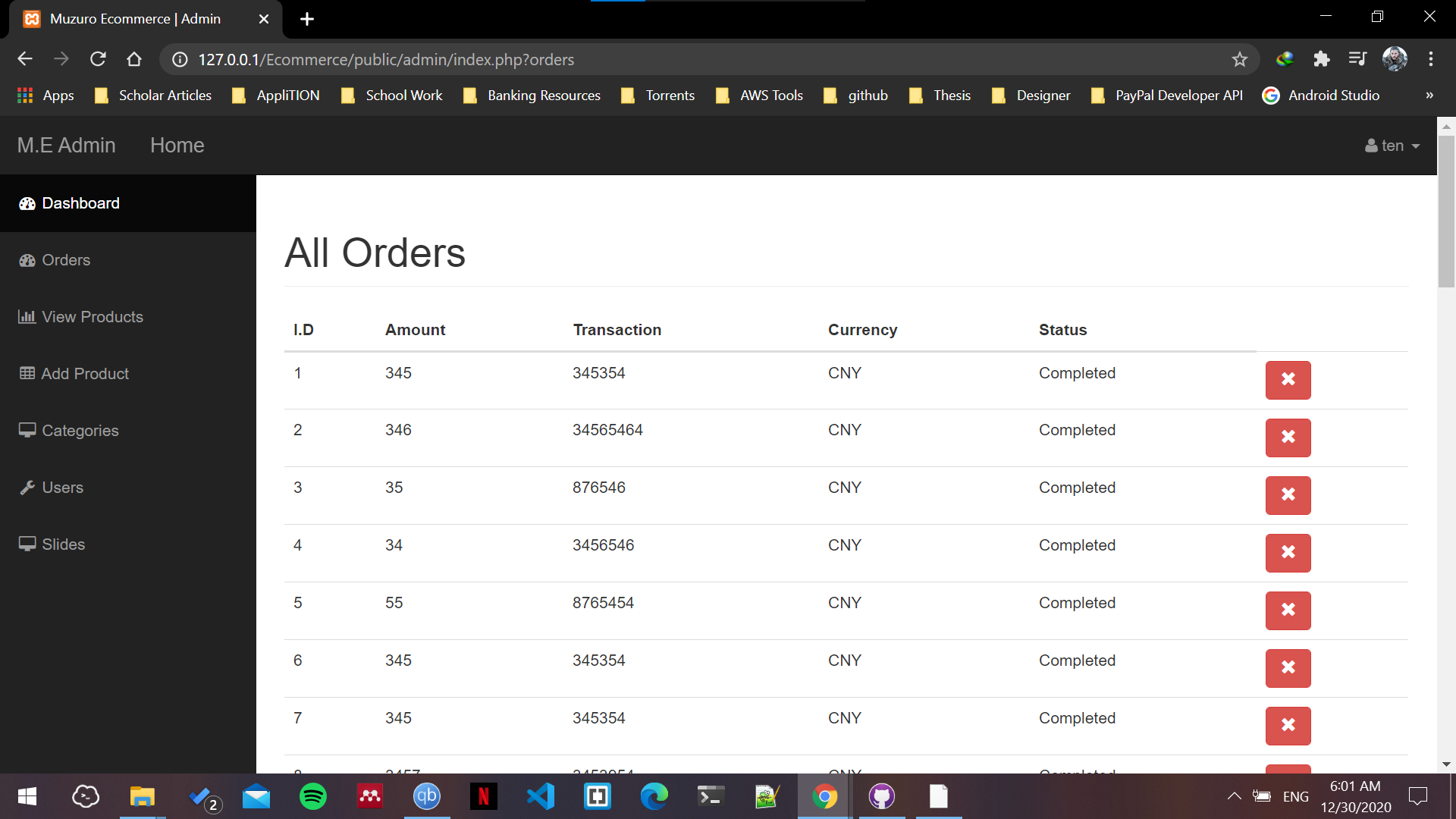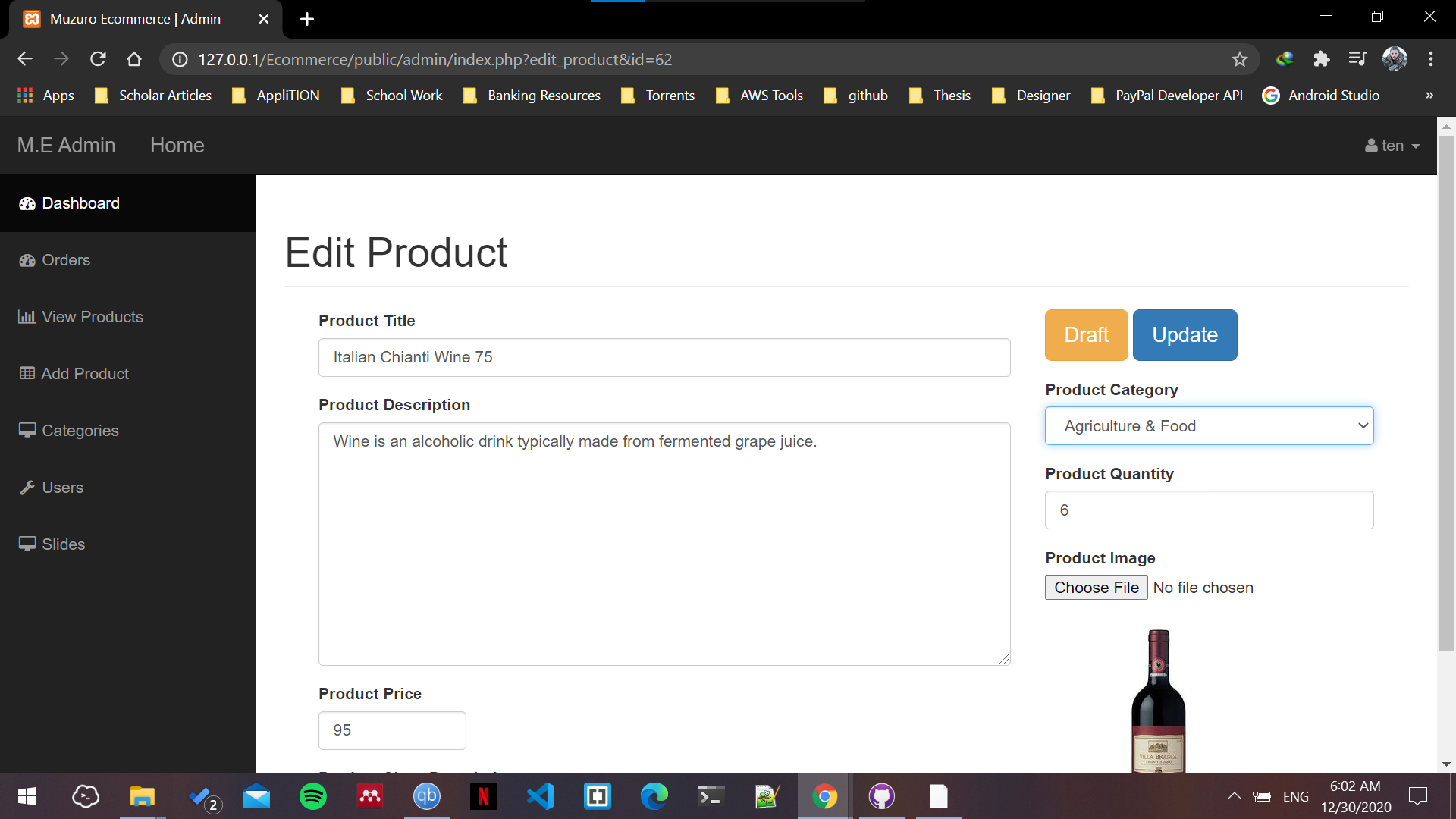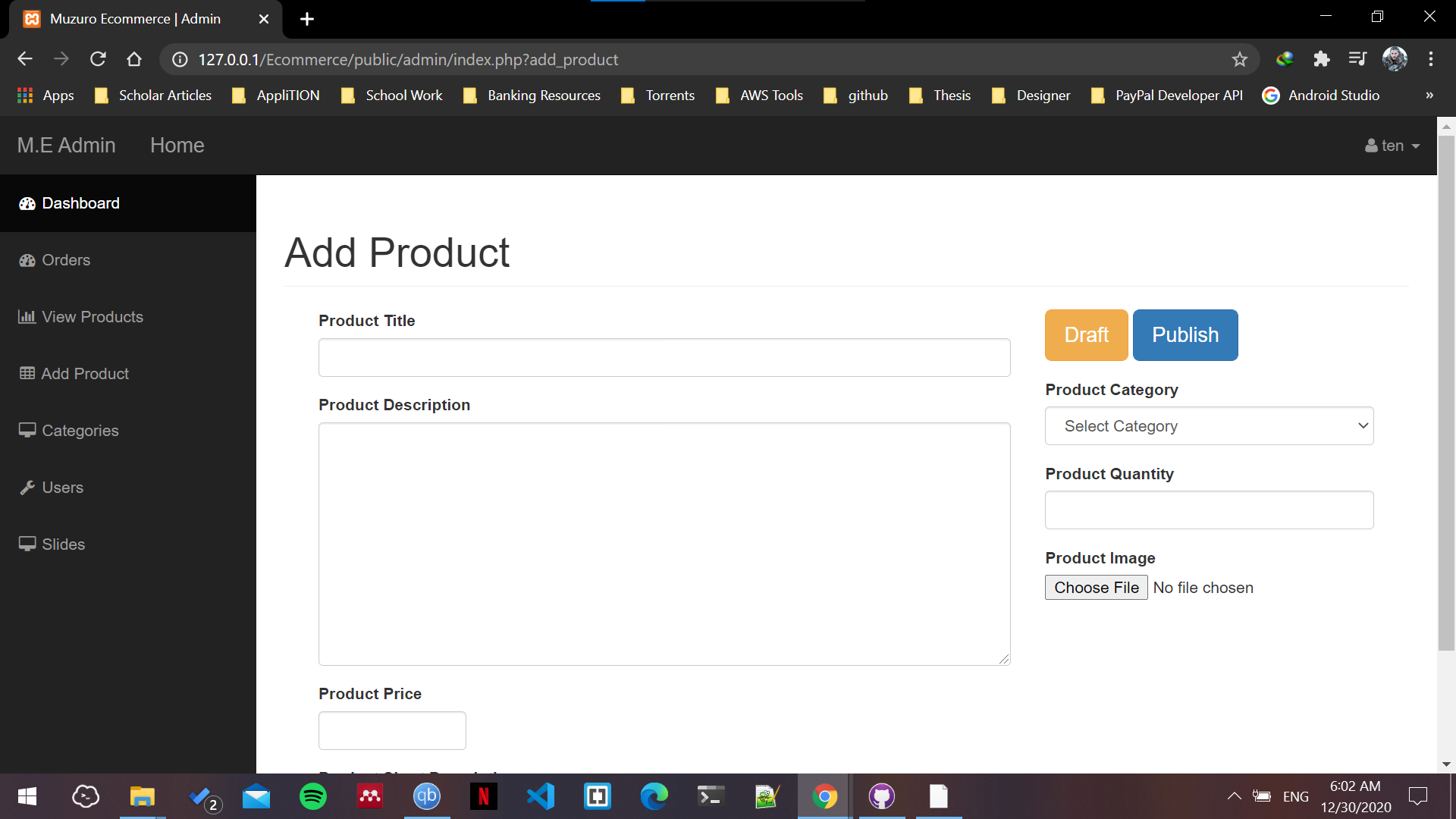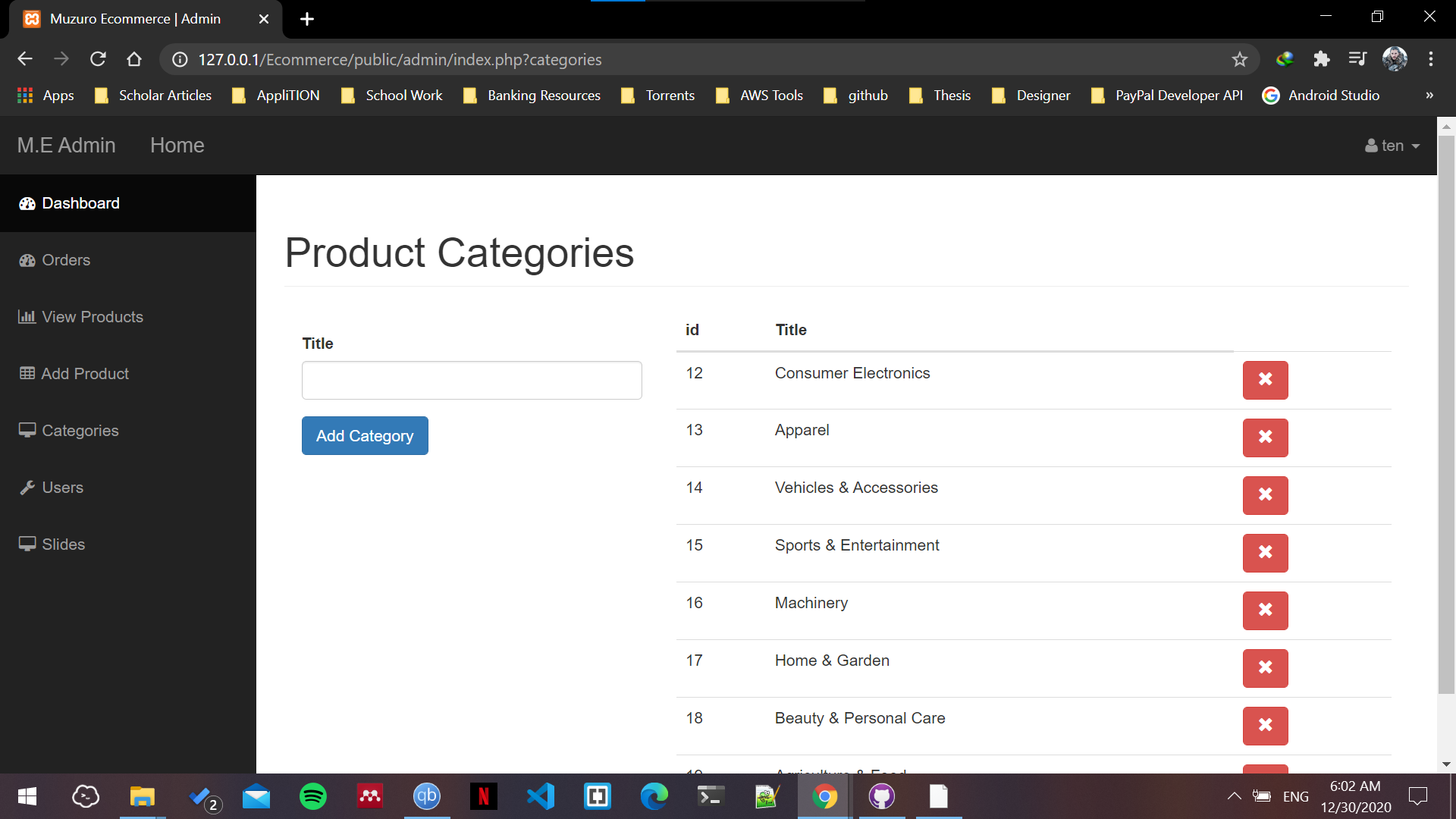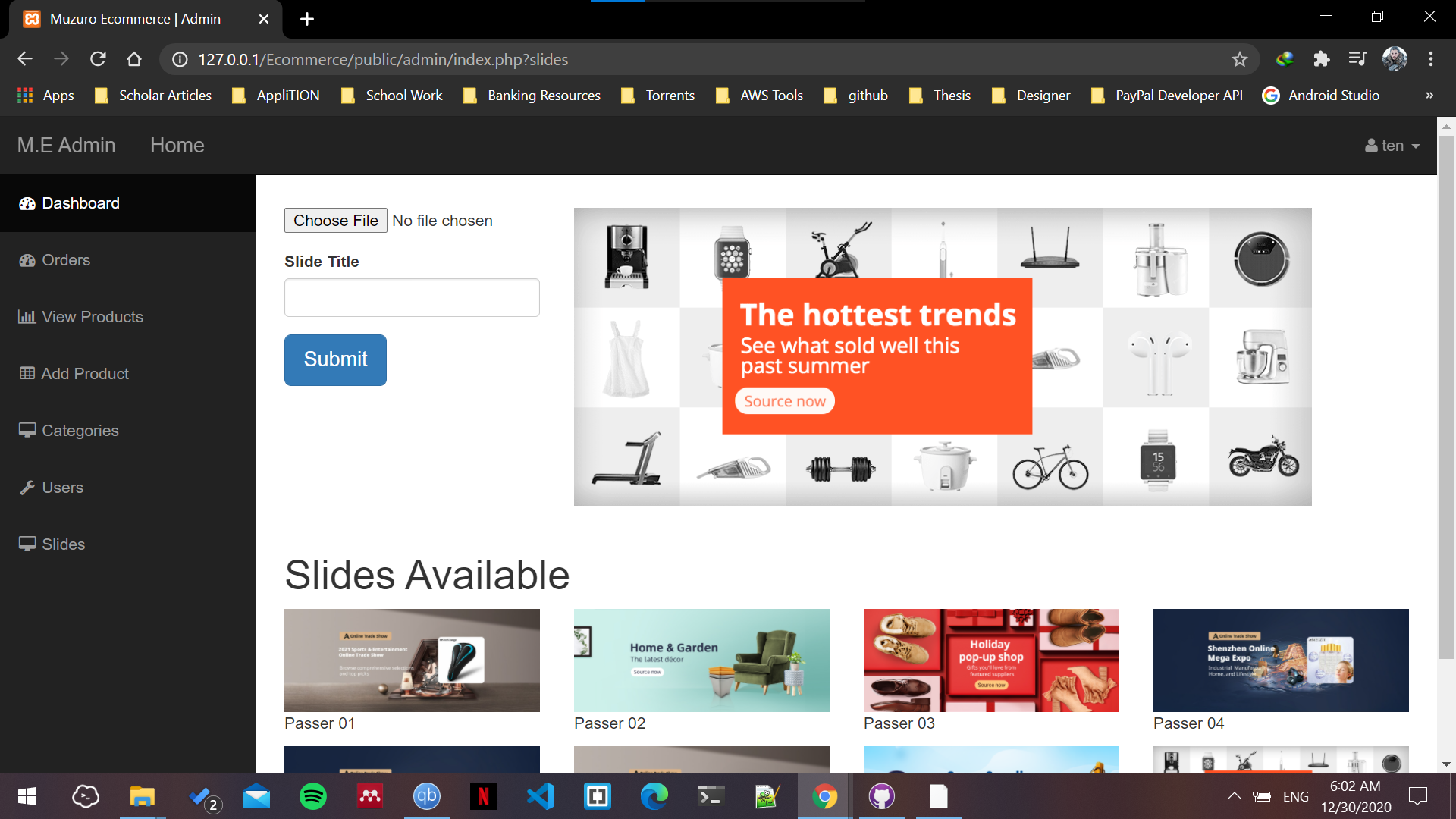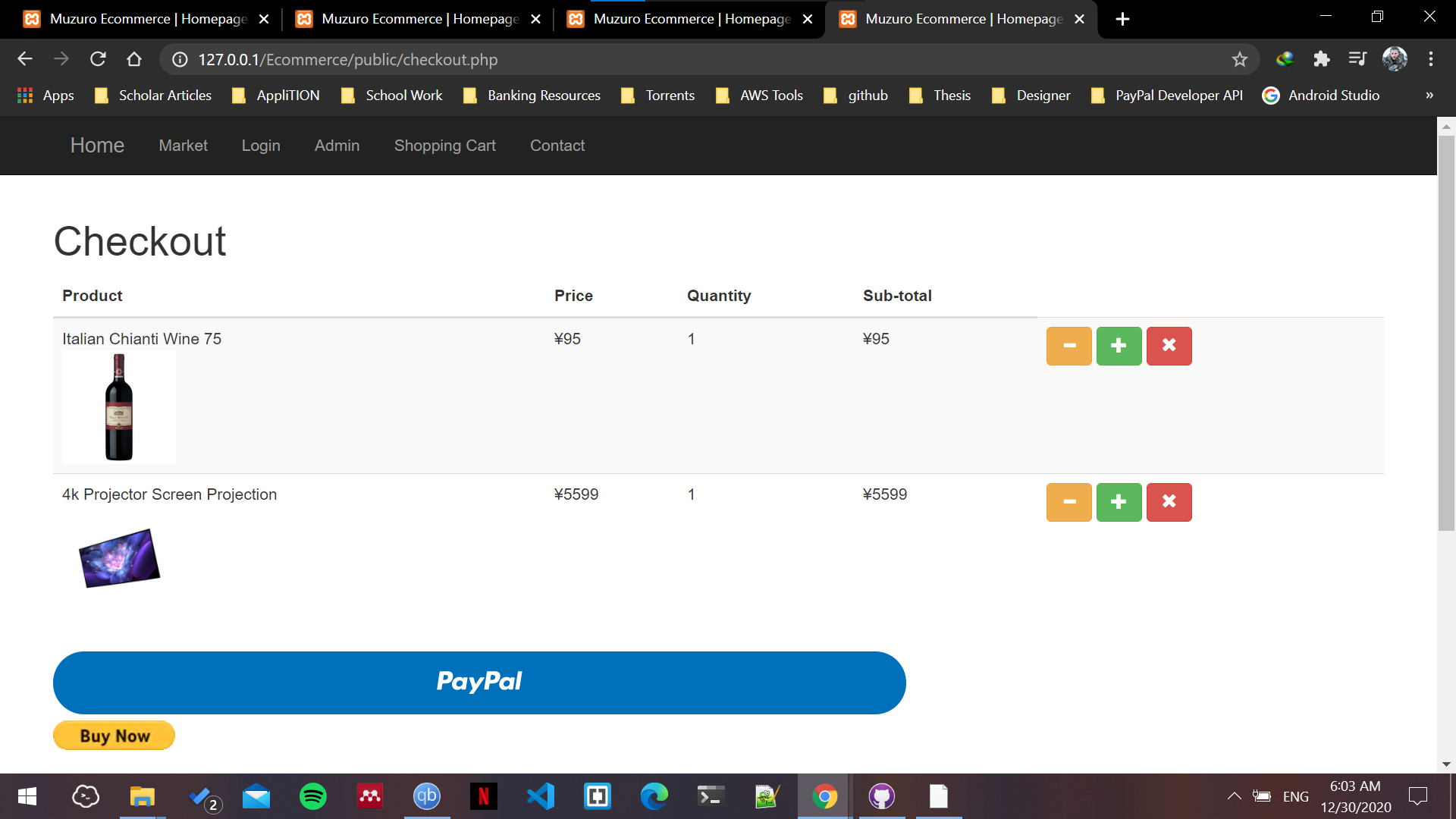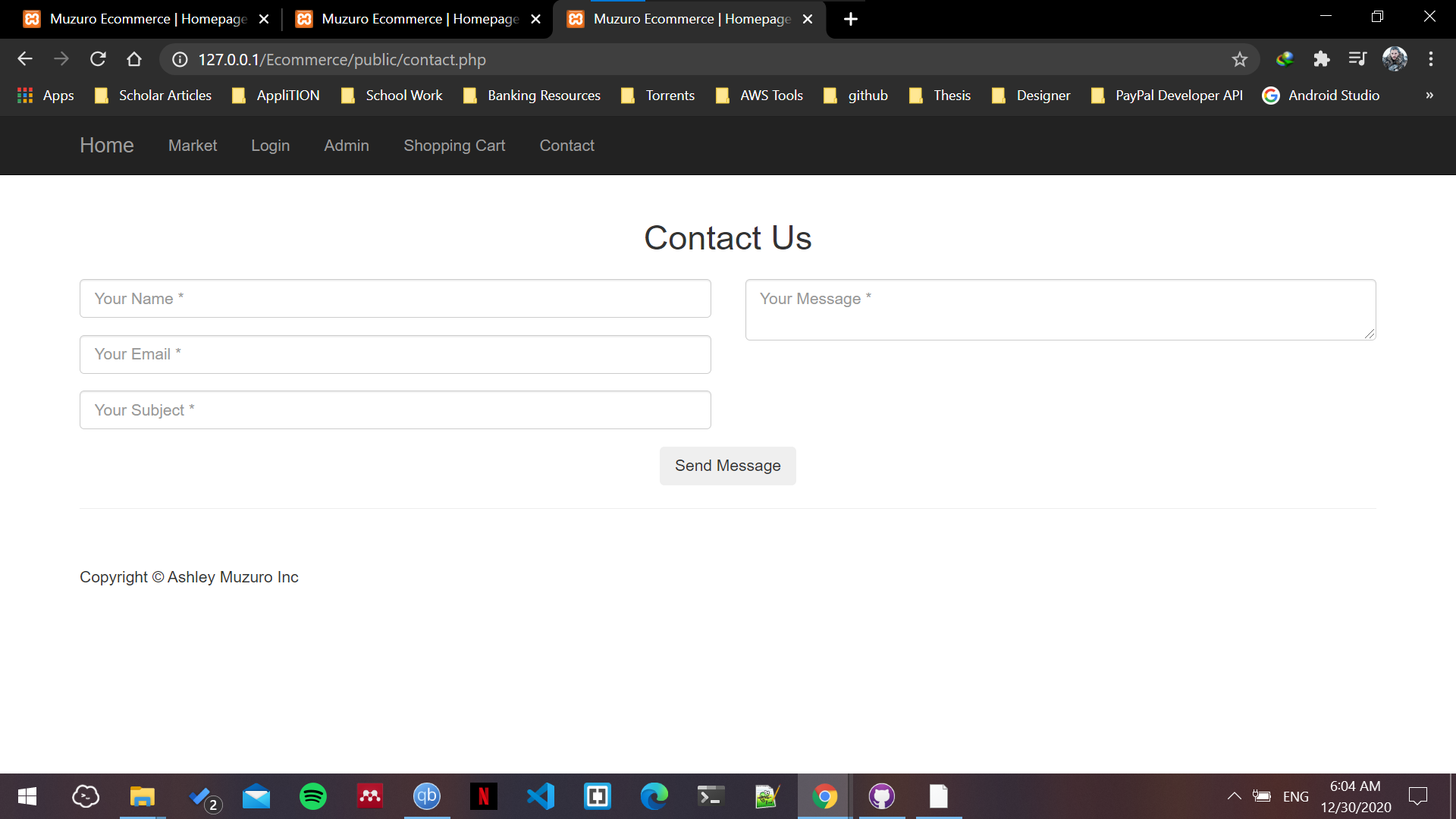Muzuro Ecommerce System (M.E.S) project.
- To set this web application, make sure PHP and PHPMyAdmin is installed on your server.
- Next open PHPMyAdmin, create a database and import the ecom_db.sql file. This will generate tables in your database on your server.
- Upload all files on your server except for ecom_db.sql!
- The admin user which I have made has an email id ashley2@personal.com / tendai@business.com(admin) and the password is 1234. (Please confirm this in db or create one manually.)
- Open config.php file and add the details of your PHPMyAdmin's id and password to access the database. Now re-upload this file to the server.
- Once this is done, go to the url of your website and it should be up and running. Enjoy!
CHAPTER 1 INTRODUCTION:- The broad definition of e-commerce transactions refers to the selling and buying of products and services over computer-mediated networks while the end process of payment and delivery is managed offline. Electronic Commerce (e-commerce) is defined as the conduct of commerce in goods and services, with the assistance of telecommunications and telecommunications-based tools such as the Internet. E-commerce is often used in a much broader sense, to mean essentially the same as “electronic business” (EB). E-commerce encompasses many areas, which include electronic catalogues that refer to means whereby sellers can communicate their offerings to potential buyers.
1.1 BACKGROUND: - E-Commerce is fast gaining ground as an accepted and used business paradigm. More and more business houses are implementing web sites providing functionality for performing commercial transaction over the web. It is reasonable to say that the process of shopping on the web is becoming commonplace. The eCommerce websites to track users in order to maximize their turnover. Simply put, the more insight a commercial website has into its customer’s actions and interest, the better it can present its product to the specific user, the more it will sell. The central concept of the application is to allow the customer to shop virtually using the Internet and allow customers to buy the items and products of their desire from the store. and allow customers to buy the items and articles of their desire from the store. An online store is a virtual store on the Internet where customers can browse the category and select products of interest. The selected items may be collected in a shopping cart. At checkout time, the items in the shopping cart will be presented as an order. At that time, more information will be needed to complete the transaction. Usually, the customer will be asked to fill or select a billing address, a shipping address, and payment information such as Card or Cash on Delivery. An email notification is sent to the customer as soon as the order is placed.
1.2 OBJECTIVE: - The Online Shopping is the process whereby consumers directly buy goods and services without any intermediary service over the internet. The goal of this website is to develop a web-based interface for eCommerce website, the website would be easy to use and hence the shopping experience pleasant for the users. The main goal of this website is: • To develop an easy to use web-based interface where customers can search for products, view a complete description of the product and order the product. • Reach out to a larger audience - internet access is becoming so mainstream now that your product/service can reach almost everyone on the planet with an internet-enabled device. • Your virtual shop remains open and operational 24x7 even if you/your staff are not working- this might not be wholly true if your product is a service-which requires immediate human-intervention. • In most cases; you need not maintain the whole stock of products - again this varies for different business models and will work greatly if you have a good supplier who does not defaults on supplies and a good shipping partner/team who work in sync for delivery. • You build your brand more quickly - as more people will know and talk and post and blog about you on social networks. • Once your brand is built you can diversify easily and also pull out of a certain segment if that does not work out for you with minimal losses - typical example will be Flipkart's music(tunes) store which closed off even being a great initiative. • For most part, setting up a website and maintaining it is lots cheaper given the plethora of hosting services available.
1.3 PURPOSE, SCOPE, APPLICABILITY: -
1.3.1 PURPOSE: - With advancements in technology and with the popularity of the internet, more and more people are turning to the web for a variety of purposes. The internet is no longer limited to searching information or connecting with people but is a platform where you can also buy and sell products. An ecommerce website is a website which allows your business to sell products and services to their online audience. These days, an increasing number of consumers prefer making most of their purchases online and in such a scenario, having an ecommerce website for your business is the need of the hour. The following is a list of the top 5 reasons to have an ecommerce platform: - Wider customer reach-when you sell a product or service through a national or global platform of an ecommerce website, then you tend to reach out to a much wider audience as compared to traditional commerce methods. This gives you a broader audience and hence possibility of better overall sales. Ability to be open 24/7-with an ecommerce website, you will give your audiences to purchase from you not just during regular store hours but throughout the day. Whether it is Sunday or a national holiday, your store is always open. This too helps you to make more sales, hence boosting sales. Better conversion rates-no matter how popular your brand is, if conversion rate is low, then profits will be low. Having an ecommerce platform helps you to increase your conversion rate since people get a chance to immediately buy from you rather than wait to visit the store. Easier to set up-an ecommerce platform is definitely much easier to set up and run than an actual physical store. There are many good website development and management platforms which can easily do this task for you at reasonable rates. It is not just easier but also a lot cheaper. Reduced risk, increased profitability-to manage and run an online store, you need a smaller workforce, thus increasing margin between profits and spending. Also, there is also the advantage of reduced risk which adds to the list of the benefits of having an ecommerce store. Having an ecommerce website gives you a certain competitive edge over those who may still not have gone online. Customers these days are looking for the easiest and cheapest way to make their purchasing and thus search online for their desired products and services. In such a case, the presence of an online store not only helps you to retain existing customers but also attract new ones.
1.3.2 SCOPE: - Nowadays, India is in a completely growing stage of development and we need to update our business to the growing needs of the new generation. There is a huge scope of eCommerce. The current generation completely belongs to e-services. Today, every business and service are going the ‘internet’ way. Everyone prefers e-services and e-governance which are the most preferred ways to connect to the people around the world. According to a report released by an American Information Technology Research & Advisory Corporation known as Garner, “e-commerce in India will probably exceed $6 Billion in profits by 2015, estimating a 70% growth from a year-ago”. Nearly 8 million people did their shopping from one of top 4 online shopping websites in 2012, and the number has grown to 35 million this year. By 2016, this online consumer base will rise to nearly 3 times to 100- million, and over 50 percent of the new buyers could be from Tier-I and Tier-II towns. This makes China one of the wildest-growing e-commerce markets in the Asia Pacific region.
1.3.3 APPLICABILITY: - E-Commerce Website with Visitor Tracking System is applicable in such areas where the people want following tasks to do: • Customers will be able to login/register into the website. • Customers will also be able to easily search for products by using different keywords like name, category wise etc and will be able to refine their results by using filters such as price, product type etc. on the website. • If the user is comfortable with some product then he/ she can purchase the product. • Customers will be able to make payments for their orders by using integrated payment gateway given by the Admin. • Once the payment is done then the user will get the product at the user location. • Customers will be able to receive an email for confirmation after an order placed on the website. • Admin will be able to manage the customers, products, orders etc on the website from the backend. • Provide the basic pages (i.e., about us, Contact Us, FAQ, help) for company information.
CHAPTER 2 SURVEY OF TECHNOLOGY In this project the following technologies are used: -
MySQL Database: - MySQL is an open-source relational database management system (RDBMS). Its name is a combination of "My", the name of co-founder Michael Widenius's daughter, and "SQL", the abbreviation for Structured Query Language. The MySQL development project has made its source code available under the terms of the GNU General Public License, as well as under a variety of proprietary agreements. MySQL was owned and sponsored by a single for-profit firm, the Swedish company MySQL AB, now owned by Oracle Corporation. For proprietary use, several paid editions are available, and offer additional functionality. In 2010, when Oracle acquired Sun, Widenius forked the open-source MySQL project to create MariaDB. MySQL is a central component of the LAMP open-source web application software stack (and other "AMP" stacks). LAMP is an acronym for "Linux, Apache, MySQL, Perl/PHP/Python". Applications that use the MySQL database include: TYPO3, MODx, Joomla, WordPress, Simple Machines Forum, phpBB, MyBB, and Drupal. MySQL is also used in many high-profile, large-scale websites, including Google (though not for searches), Facebook, Twitter, Flickr, and YouTube.
HTML: - Hypertext Mark-up Language (HTML) is the standard mark-up language for creating web pages and web applications. With Cascading Style Sheets (CSS) and JavaScript it forms a triad of cornerstone technologies for the World Wide Web. Web browsers receive HTML documents from a webserver or from local storage and render them into multimedia web pages. HTML describes the structure of a web page semantically and originally included cues for the appearance of the document. HTML elements are the building blocks of HTML pages. With HTML constructs, images and other objects, such as interactive forms, may be embedded into the rendered page. It provides a means to create structured documents by denoting structural semantics for text such as headings, paragraphs, lists, links, quotes and other items. HTML elements are delineated by tags, written using angle brackets. Tags such as and introduce content into the page directly. Others such as surround and provide information about document text and may include other tags as sub-elements. Browsers do not display the HTML tags, but use them to interpret the content of the page. HTML can embed programs written in a scripting language such as JavaScript which affect the behaviour and content of web pages. Inclusion of CSS defines the look and layout of content. The World Wide Web Consortium (W3C), maintainer of both the HTML and the CSS standards, has encouraged the use of CSS over explicit presentational HTML since 1997.
CSS: - CSS is designed to enable the separation of presentation and content, including layout, colours, and fonts. This separation can improve content accessibility, provide more flexibility and control in the specification of presentation characteristics, enable multiple web pages to share formatting by specifying the relevant CSS in a separate ‘.css’ file, and reduce complexity and repetition in the structural content. Separation of formatting and content also makes it feasible to present the same mark-up page in different styles for different rendering methods, such as on-screen, in print, by voice (via speech-based browser or screen reader), and on Braille-based tactile devices. CSS also has rules for alternate formatting if the content is accessed on a mobile device. The name cascading comes from the specified priority scheme to determine which style rule applies if more than one rule matches a particular element. This cascading priority scheme is predictable.
Bootstrap: - Bootstrap is a free and open-source front-end web framework for designing websites and web applications. It contains HTML- and CSS-based design templates for typography, forms, buttons, navigation and other interface components, as well as optional JavaScript extensions. Unlike many web frameworks, it concerns itself with front-end development only. Bootstrap is the second most-starred project on GitHub, with more than 107,000 stars and 48,000 forks. Bootstrap, originally named Twitter Blueprint, was developed by Mark Otto and Jacob Thornton at Twitter as a framework to encourage consistency across internal tools. Before Bootstrap, various libraries were used for interface development, which led to inconsistencies and a high maintenance burden. According to twitter developer Mark Otto: “A super small group of developers and I got together to design and build a new internal tool and saw an opportunity to do something more. Through that process, we saw ourselves build something much more substantial than another internal tool. Months later, we ended up with an early version of Bootstrap as a way to document and share common design patterns and assets within the company.” After a few months of development by a small group, many developers at Twitter began to contribute to the project as a part of Hack Week, a hackathon-style week for the Twitter development team. It was renamed from Twitter Blueprint to Bootstrap, and released as an open source project on August 19, 2011. It has continued to be maintained by Mark Otto, Jacob Thornton, and a small group of core developers, as well as a large community of contributors.
PHP7
CHAPTER 3 REQUIREMENT AND ANALYSIS 3.1 PROBLEM DEFINATION: -
This project aims to develop an online shopping for customers with the goal so that it is very easy to shop your loved things from an extensive number of online shopping sites available on the web. With the help of this you can carry out an online shopping from your home. Here is no compelling reason to go to the crowed stores or shopping centres during festival seasons. You simply require a PC or a laptop or a mobile phone and one important payment sending option to shop online. To get to this online shopping system all the customers will need to have an email and password to login and proceed your shopping. The login credentials for an online shopping system are under high security and nobody will have the capacity to crack it easily. Upon successful login the customers can purchase a wide range of things such as mobiles, books, apparel, jewellery, infant care, gifts, tools, etc. can be dispatched using online shopping system. Not just these, you can also purchase from outside nations by few clicks on your mouse. And of course, you will get your requested ordered items at your door step. It is simple. You will pick your favourite items from variety of online shopping sites looking at cost and quality. No need to go physical shops with this you will have more time to spend with your family. It Just need a computer and a payment making options like net banking, credit card, debit card or PayPal. Almost a wide range of things can be brought through online shopping system. You can purchase goods from foreign places from your bedroom and you will get your goods at your home. It is extremely secure. Customer service is accessible.
3.2 REQUIREMENT SPECIFICATION: -
FUNCTIONAL REQUIREMENTS: - Registration: - A new user will have to register in the system by providing essential details in order to view the products in the system. The admin must accept a new user by unblocking him. Login: - A user must login with his user name and password to the system after registration. Add Products The shopping cart project contains different kind of products. The products can be classified into different categories by name. Admin can add new products into the existing system with all its details including an image. View Products: - User can view the list of products based on their names after successful login. A detailed description of a particular product with product name, products details, product image, price can be viewed by users. Delete Products: - Administrator can delete the products based on the stock of that particular product. Search products: - Admin will have a list view of all the existing products. He can also search for a particular product by name. View Order: - Administrator can view the Orders which is generated by the users. He can verify the details of the purchase. Delete Order: - Admin can delete order from the orders list when the product is taken for delivery. Add to cart: - The user can add the desired product into his cart by clicking add to cart option on the product. He can view his cart by clicking on the cart button. All products added by cart can be viewed.
NON-FUNCTIONAL REQUIREMENTS: - i. EFFICIENCY REQUIREMENT: - When an online shopping cart android application implemented customer can purchase product in an efficient manner. ii. RELIABILITY REQUIREMENT: - The system should provide a reliable environment to both customers and owner. All orders should be reaching at the admin without any errors. iii. USABILITY REQUIREMENT: - The android application is designed for user friendly environment and ease of use. iv. IMPLEMENTATION REQUIREMENT: - Implementation of the system using CSS and html in front end with just as back end and it will be used for database connectivity. And the database part is developed by MySQL. Responsive web designing is used for making the website compatible for any type of screen. v. DELIVERY REQUIREMENT: - The whole system is expected to be delivered in four months of time with a weekly evaluation by the project guide.
3.3 PLANNING AND SCHEDULING: -
GANTT CHART: - PERT CHART: -
3.4 SOFTWARE AND HARDWARE REQUIREMENTS: - Hardware Requirements: - ➢ Operating System: - Windows 7 and above ➢ Processor: - Intel i3 or above ➢ Installed Memory (RAM): - Minimum 1 GB ➢ System Type: - 32-bit or 64-bit Operating System Software Requirements: - ➢ Front End: - HTML, CSS, JS, Bootstrap ➢ Back End: - Python Django Framework, MySQL
3.5 PRELIMINARY PRODUCT DESCRIPTION: - This project is a web-based shopping system for an existing shop. The project objective is to deliver the E-Commerce Website like Muzuro Ecommerce System based on PHP and Bootstrap 4. E-Commerce Website with Visitor Tracking system is the process whereby consumers directly buy goods or products from a seller in real-time, over the Internet. It is a form of electronic commerce. This project is an attempt to provide the advantages of online shopping system to customers of a real shop. It helps buying the products in the shop anywhere through internet. Thus, the customer will get the service of E-Commerce Website and home delivery for that product.
3.6CONCEPTUAL MODEL: -
3.6.1 Event Table: -
3.6.2 Use Case Diagram: -
3.6.3 Sequence Diagram: -
3.6.4 Class Diagram: -
3.6.5 State Chart Diagram: -
CHAPTER 4 SYSTEM DESIGN
4.1 BASIC MODULES: -
Customer Module: - The main purpose of this module is providing all the functionality related to customers. It tracks all the information and details of the customer. We have developed all type of CRUD (Create, Read, Update and Delete) operations of the customers. This is a role-based module where admin can perform each and every operation on data but the customer will be able to view only his/her data, so access level restrictions has also been implemented on the project.
Features of Customer Module: -
- • Admin can add new customers records
- • Admin can see the list of customers details
- • Only admin can edit and update the record of the customers
- • Admin will be able to delete the records of the customers
- • Customer will be able to see his details
- • Customer will be able to update his details
Category Module: - The main purpose for developing this module is to manage the category of the product data wise. So, all product category will be managed by admin and customer will be able to see product category. Admin can see the list of all the product category and filter it according to the customers.
Features of Category Module:
- • Admin can manage the category
- • Admin can edit/delete the category
- • Admin can see the list of all category
- • Customer can see category
Product Module: - The main purpose for developing this module is to manage the product. So, all category of product will be managed by admin and customer will be able to see the product.
Features of product Module: -
- • Admin can manage the product
- • Admin can edit/delete the product
- • Admin can see the list of all product
- • Customer can see product
Order Module: - The main purpose for developing this module is to manage the customer orders for the product. So, all orders will be managed by admin and customer will be able to see his order and their payment receipt.
Features of Order Module:
- • Admin can manage the order
- • Admin can edit/delete the order
- • Admin can see the list of all order
- • Customer can see his order Functionality
Admin user: These are the functionality performed by the admin users: -
- • Login for Admin
- • Change Password for Admin
- • Logout Functionality
- • Dashboard for Admin User
- • Manage Category
- • Adding New Category
- • Edit the Exiting Category
- • View details of the Category
- • Listing of all Category
- • Manage Customer
- • Adding New Customer
- • Edit the Exiting Customer
- • View details of the Customer
- • Listing of all Customer
- • Manage Product
- • Adding New Product
- •Edit the Exiting Product
- • View details of the Product
- • Listing of all Product
- • Advertising Popular Products
- • View details of the Order
- • Listing of all Order
Functionality performed by Customer user: - Customer Registration: - • Any customer can register on website using the registration module. • Customer Login: This is the login form, from where customer can login into the system • Customer Payment: Customer can manage all the product payment from this form. • Item Cart: This is item cart form in this project. • Customer Order Receipt: This customer gets order receipt form details. • Customer My Order: This customer gets my order form details. • Change Password: This is the change password module from where customer change his account password.
4.2 DATA DESIGN: -
4.2.1 Schema Design with Data Integrity and Constraints: -
4.2.2 Database Relationship Design: -
4.3 USER INTERFACE DESIGN: -
4.4 SECURITY ISSUES: - ➢ E-commerce Security Risks Currently Faced by Online Retailers Security risks associated with e-commerce can be as a result of human error, an accident or unauthorized access to systems. Online retailers are most likely to face credit card fraud or data errors. Their online stores are also likely to face phishing attacks, distributed denial of service (DDoS) attacks and man-in-the-middle attacks as explained below. Credit Card Fraud: - Credit card fraud is the most common security threat that online retailers face. It occurs when a hacker gains unauthorized access to customers’ personal and payment information. To access this data, the hacker may penetrate the database of an e-commerce site using malicious software programs. At times, a hacker’s intention when stealing customers’ data is to sell it on black markets. Phishing Scams: - E-commerce sites are also prone to phishing scams sent by known or unknown people in form of emails. These scams focus on targeting important user data like credit card numbers and login credentials. An attacker may use a scheme known as social engineering to lure online shoppers to give out their personal information. When sent in an email to an online shopper, a phishing scam may contain a link to a malicious site that resembles an e-commerce site.
➢ Best Practices to Curb the Security Issues in E-commerce Fraud costs online retailers billions of dollars yearly. To solve the security issues in ecommerce, merchants and payment companies should collaboratively come up with effective solutions. Though these security issues are becoming intense with time, there are solutions that online retailers can implement without affecting the user experience of their sites. In other words, they can adopt the following solutions without impacting the customer experience. Require stronger passwords: - The reason why hackers easily gain access to users’ login credentials is that most ecommerce sites fail to ask users to provide stronger passwords. Hackers can utilize algorithms to figure out the passwords easily. A strong password contains a mix of alphabetical letters and numbers. Use SSL Certificates: - It is mandatory for e-commerce websites to have SSL certificates for facilitating secure user connections. These certificates are also useful in authenticating the identity of an online retail business and securing users’ checkout data. They also keep customers of online retail stores protected from financial fraud or information loss.
4.5 TEST CASE DESGIN: -

